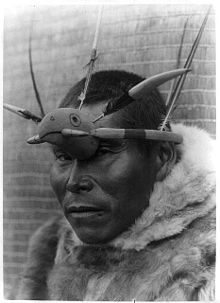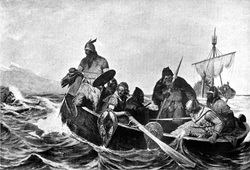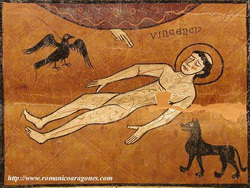Raven Lore, Assorted Traditions
By Andy Hagerty and others
As we research various topics, we continually come across references to ravens, Raven stories and myths and other interesting tales. We are going to collect them here for your entertainment, enlightenment and edification.
How the Raven helped the people from the Pacific Northwest

Long ago, near the beginning of the world, Gray Eagle was the guardian of the
Sun, Moon and Stars, of fresh water, and of fire. Gray Eagle hated people so
much that he kept these things hidden. People lived in darkness, without fire
and without fresh water.
Gray Eagle had a beautiful daughter, and Raven fell in love with her. In the
beginning, Raven was a snow-white bird, and as a such, he pleased Gray Eagle's
daughter. She invited him to her father's longhouse.
When Raven saw the Sun, Moon and stars, and fresh water hanging on the sides
of Eagle's lodge, he knew what he should do. He watched for his chance to seize
them when no one was looking. He stole all of them, and a brand of fire also,
and flew out of the longhouse through the smoke hole. As soon as Raven got
outside he hung the Sun up in the sky. It made so much light that he was able to
fly far out to an island in the middle of the ocean. When the Sun set, he fastened the Moon up in the sky and hung the stars around in different places. By this new light he kept on flying, carrying with him the fresh water and the brand of fire he had stolen.
He flew back over the land. When he had reached the right place, he dropped all the water he had stolen. It fell to the ground and there became the source of all the fresh-water streams and lakes in the world. Then Raven flew on, holding the brand of fire in his bill. The smoke from the fire blew back over his white feathers and made them black. When his bill began to burn, he had to drop the firebrand. It struck rocks and hid itself within them. That is why, if you strike two stones together, sparks of fire will drop out.
Raven's feathers never became white again after they were blackened by the smoke from the firebrand. That is why Raven is now a black bird.
Sun, Moon and Stars, of fresh water, and of fire. Gray Eagle hated people so
much that he kept these things hidden. People lived in darkness, without fire
and without fresh water.
Gray Eagle had a beautiful daughter, and Raven fell in love with her. In the
beginning, Raven was a snow-white bird, and as a such, he pleased Gray Eagle's
daughter. She invited him to her father's longhouse.
When Raven saw the Sun, Moon and stars, and fresh water hanging on the sides
of Eagle's lodge, he knew what he should do. He watched for his chance to seize
them when no one was looking. He stole all of them, and a brand of fire also,
and flew out of the longhouse through the smoke hole. As soon as Raven got
outside he hung the Sun up in the sky. It made so much light that he was able to
fly far out to an island in the middle of the ocean. When the Sun set, he fastened the Moon up in the sky and hung the stars around in different places. By this new light he kept on flying, carrying with him the fresh water and the brand of fire he had stolen.
He flew back over the land. When he had reached the right place, he dropped all the water he had stolen. It fell to the ground and there became the source of all the fresh-water streams and lakes in the world. Then Raven flew on, holding the brand of fire in his bill. The smoke from the fire blew back over his white feathers and made them black. When his bill began to burn, he had to drop the firebrand. It struck rocks and hid itself within them. That is why, if you strike two stones together, sparks of fire will drop out.
Raven's feathers never became white again after they were blackened by the smoke from the firebrand. That is why Raven is now a black bird.
Hrafna-Flóki Vilgerðarson and Iceland

Flóki Vilgerðarson ( 9th century) was the first Norseman to deliberately sail to Iceland
(called Garðarshólmi) with the plan to make a permanent settlement.. In a sort oddly remincent to the Noah story of the Bible he used Ravens to guide his way. His story is documented in the
Landnámabók manuscript. This manuscript is seen as the record of he settlement
of Iceland.
Although there is evidence of Scottish Christian Monks living there as early
as 800 AD, and several Norsemen had discovered the Island prior to this, He was
the first who wanted to settle in this new land and so he took his family and livestock with him. During his travels to this new land he landed in the Faroe Islands. There he took three ravens to help him find his way to Iceland, and thus, he was nicknamed Raven-Floki and he is commonly remembered by that name.
After sailing for a while from the Faroe Islands, Floki set one of the ravens free. The first raven flew back to the Faroe Islands. Later Floki
released the second raven, which flew up in the air and back on board. Flocki released the third raven a short time later and this time the raven flew northwest and did not return. Floki now knew they were close to land, and so they followed the third raven.
(called Garðarshólmi) with the plan to make a permanent settlement.. In a sort oddly remincent to the Noah story of the Bible he used Ravens to guide his way. His story is documented in the
Landnámabók manuscript. This manuscript is seen as the record of he settlement
of Iceland.
Although there is evidence of Scottish Christian Monks living there as early
as 800 AD, and several Norsemen had discovered the Island prior to this, He was
the first who wanted to settle in this new land and so he took his family and livestock with him. During his travels to this new land he landed in the Faroe Islands. There he took three ravens to help him find his way to Iceland, and thus, he was nicknamed Raven-Floki and he is commonly remembered by that name.
After sailing for a while from the Faroe Islands, Floki set one of the ravens free. The first raven flew back to the Faroe Islands. Later Floki
released the second raven, which flew up in the air and back on board. Flocki released the third raven a short time later and this time the raven flew northwest and did not return. Floki now knew they were close to land, and so they followed the third raven.
Of Saint’s and Ravens, St Benedict of Nurcia (480-547), Catholic

On the front of the medal of Saint Benedict of Nurcia (480-547) holding a
cross in his right hand, the object of In the back is a poisoned cup, in
reference to the legend of Benedict. The story goes as thus:
At the death of the Abbot of Subiaco the community came to him and begged him
to become its new abbot. Benedict was acquainted with the life and discipline of
the monastery, and knew that "their manners were diverse from his and therefore
that they would never agree together“. Eventually overcome with their entreaty,
he gave his consent.
The experiment failed; the monks tried to poison him. The legend goes that
they first tried to poison his drink. He prayed a blessing over the cup and the
cup shattered. Then they tried to poison him with poisoned bread. When he prayed a blessing over the bread, a Raven swept in and took the loaf away.
Benedict returned to his cave above Subiaco. Many people became attacted to Benedict due to his sanctity and character. He founded 12 monasteries in the vicinity of Subiaco, and, eventually, founded the great Benedictine monastery of Monte Cassino, which lies on a hilltop between Rome and Naples.
cross in his right hand, the object of In the back is a poisoned cup, in
reference to the legend of Benedict. The story goes as thus:
At the death of the Abbot of Subiaco the community came to him and begged him
to become its new abbot. Benedict was acquainted with the life and discipline of
the monastery, and knew that "their manners were diverse from his and therefore
that they would never agree together“. Eventually overcome with their entreaty,
he gave his consent.
The experiment failed; the monks tried to poison him. The legend goes that
they first tried to poison his drink. He prayed a blessing over the cup and the
cup shattered. Then they tried to poison him with poisoned bread. When he prayed a blessing over the bread, a Raven swept in and took the loaf away.
Benedict returned to his cave above Subiaco. Many people became attacted to Benedict due to his sanctity and character. He founded 12 monasteries in the vicinity of Subiaco, and, eventually, founded the great Benedictine monastery of Monte Cassino, which lies on a hilltop between Rome and Naples.
Celtic trees

In Celtic tradition many different trees have resident spirits who have
various properties or spheres of influence. The Alder tree was seen as very
protective. The spirits within additionally have great knowledge about scrying
with water and mirrors.
When the spirit in the tree would leave, it would take the form of a Raven.
various properties or spheres of influence. The Alder tree was seen as very
protective. The spirits within additionally have great knowledge about scrying
with water and mirrors.
When the spirit in the tree would leave, it would take the form of a Raven.
Of Saint’s and Ravens, Vincent of Saragossa (304), Catholic

In 304 ad Vincent of Saragossa was martyred by the governor of Spain Dacian
under the edicts of Emperor Diocletian. His body was thrown into a bog as prey
to the wild birds and beasts, but it was strangely preserved it is said by the
protection of ravens. When any wild beast or bird tried to attack the mortal
remains of the saint, the ravens drove them away. Thwarted, Dacian had Vincent's
body tied to a stone and cast into the sea. But in the night it was washed
ashore, and again, protected by ravens until his followers could recover his
body. Their loving hands gave Vincent’s broken body reverent care and secret
burial.
His body was taken to what is now known as Cape St Vincent and a shrine was erected over his grave, which continued to be guarded by flocks of ravens. In the time of Muslim Rule in the Iberian Peninsula, the Arab geographer Al-Idrisi noted this constant guard by ravens, for which the place was named by him كنيسة الغراب "Kanīsah al-Ghurāb" (Church of the Raven).
under the edicts of Emperor Diocletian. His body was thrown into a bog as prey
to the wild birds and beasts, but it was strangely preserved it is said by the
protection of ravens. When any wild beast or bird tried to attack the mortal
remains of the saint, the ravens drove them away. Thwarted, Dacian had Vincent's
body tied to a stone and cast into the sea. But in the night it was washed
ashore, and again, protected by ravens until his followers could recover his
body. Their loving hands gave Vincent’s broken body reverent care and secret
burial.
His body was taken to what is now known as Cape St Vincent and a shrine was erected over his grave, which continued to be guarded by flocks of ravens. In the time of Muslim Rule in the Iberian Peninsula, the Arab geographer Al-Idrisi noted this constant guard by ravens, for which the place was named by him كنيسة الغراب "Kanīsah al-Ghurāb" (Church of the Raven).
